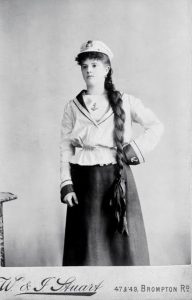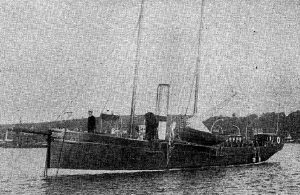
Jeannette Pairis wearing clothes with a nautical theme – possibly for trips on one of Wells’ yachts
(Picture credit: Pairis family collection)
In recent posts I’ve shown how – on rare occasions – Charles Deville Wells took other people into his confidence as partners in crime, only to be let down by them most of the time. The only accomplice he could really trust was his long-term girlfriend.
It was around 1890 – a year or so before his famous bank-breaking exploit at Monte Carlo. Wells had separated from his wife, and began a relationship with Jeannette Pairis, a young French woman from Alsace. At the time he was fifty years old and she was twenty. Not only was he old enough to be her father – he actually was a little older than her father. (And, for the record, Jeannette was a few years younger than Wells’ own daughter!)
Up to this time Jeannette had had a particularly unhappy life: she was ten when her mother died. Her father remarried barely a year later, and he and his new bride sent Jeannette and her seven brothers and sisters away to live with various families in different areas. It seems to me – reading between the lines – that they became little more than servants. Jeannette finally escaped this situation by leaving France and travelling to England. In letters to her family back home she claimed that she had been engaged to marry an English lord; but her husband-to-be had died shortly before the wedding, and his family had shunned her.
The truth, however, was that she had begun a new life with Wells in about 1890. He already had a criminal record for fraud in France, and was in the process of acquiring one in Britain, too, by fleecing investors in an elaborate scam involving patents.
Soon after they met, Wells abandoned the patent scam and started planning his first visit to Monte Carlo. This took place in mid-summer 1891, when he won the equivalent of £4 million. There is no proof that it was Jeannette who dreamed up the Monte Carlo exploit, but I feel sure that she provided the impetus for it. Wells was strongly influenced by her, and wanted to please her. In fact, on a much later occasion, he was overheard to say that all he wanted was ‘to make his little doll happy.’
He already owned a number of yachts (see my blog post of 1 October 2016, below). Now he purchased a colossal ship, and converted it into the world’s seventh-largest yacht, the Palais Royal. The vessel had a ballroom capable of holding 50 party-goers, and was equipped with a piano and an organ. With these instruments Wells – an accomplished musician – could entertain the guests. The accommodation was finished to sumptuous standards. Since Wells himself was (to quote a Scotland Yard document), ‘an exceptionally reserved man, frugal and simple in his habits’, it seems probable that the purpose of all of this extravagance was to please and impress Jeannette.
Over the years it must have been fairly obvious that Jeannette played some part in Wells’ crimes, but the authorities – perhaps feeling that it would be difficult to prove that she had been an accomplice – did not put her on trial. Wells served several prison sentences in Britain and in France and on each occasion Jeannette was waiting for him when he was released.
However, this routine changed when, in 1910-11, Wells perpetrated a colossal fraud in Paris, promising to pay investors one per cent per day interest on their deposits. This netted him a sum approaching £5 million in today’s values. With a suitcase full of cash and gold, he made weekly trips to London, where Jeannette placed the funds in various safe investments. Experience with his previous associates had proved to him that no-one else was to be trusted – especially with such large amounts of money.
But this time the significance of Jeannette’s role in the scheme couldn’t be overlooked. She had not just known about her lover’s misdeeds, but had actually taken part in the scheme. Eventually they were both arrested on Wells’ yacht, Shanklin, and brought before a court in Paris.

The yacht, Shanklin, property of Charles Wells.
A somewhat unflattering description of Jeannette – who was now in her early 40s – stated that she had ‘the look of a little housemaid who has hit the big-time. She loudly protests her innocence.’ Intent on proving that she had been an accessory, the prosecutor asked her how she accounted for Wells having become rich overnight. She merely replied that she was not at all surprised that he was poor in 1910 and a millionaire in 1911.
(Wells himself had given a similar answer when it was put to him that he could not possibly have sustained interest payments of one per cent per day to his clients: ‘To promise a return of one per cent, monsieur le président, is not an enormous promise. In business if one were to earn one franc on a capital of 100 francs it would hardly be worth mentioning. If what I promised was impossible to achieve, how is it that people start off with nothing, and then become millionaires?’)
Wells was found guilty of fraud and misuse of funds, and received a prison sentence of five years and a 3,000 franc fine. Jeannette was found guilty of complicity, given a thirteen-month jail sentence, and fined 1,000 francs. The judge implied that he would have imposed a stiffer sentence if the law had allowed him to do so.
After they completed their respective sentences there is nothing to suggest that they broke the law again. They spent the rest of their lives together, and Jeannette was with Charles when he died in the 1920s.
Postscript: recently I spent a most enjoyable evening in the company of Jeannette’s great nephew and his wife. We had already been in contact for some time by email and phone, but it was an exciting moment for me actually to meet one of Jeannette’s relatives. He was very interested to hear about her later life – an episode which seems to have been swept under the carpet within the family! And for my part I learned a lot more about the Pairis family in general.
Incidentally, there are no living descendants of Charles Wells himself – a fact which many financial institutions might well be thankful for. However a fairly substantial number of his more distant relatives are alive, many of them in Australia. I hope one day to make contact with some of them.
